

In 1975, John McPhee published a story called “Brigade de Cuisine” about Otto, a chef who ran a 55-seat restaurant with no help except for Anne (his pastry chef/wife), their children (who served the food) and a dishwasher on the weekends. Otto, which isn’t really his name, is a British-born, Spanish/British-raised, German/Swiss/Spanish-trained firecracker. He is a perfectionist, a classic old guard hefe and an obsessively inventive European chef performing miracles en croute. “The man’s right knee is callused from kneeling before the stove,” McPhee writes. “He would like to see his work described. He would like to be known for what he does, but in this time, in this country, his position is awkward, for he prefers being a person to becoming a personality, his wish to be acknowledged is exceeded by his wish not to be celebrated, and he could savor recognition only if he could have it without publicity.” The location of the restaurant: somewhere in the region of New York City.
A lot of time has passed since “Brigade de Cuisine” was written, and even back then McPhee wrote, “Otto is a wave of the past. This is the age of the microwave and the mass-produced entrée ….” Certainly 30 years later, chefs like Otto — with poignantly humble personalities in a profession replete with egos the size of tuna bellies — have all but disappeared. Chefs have become “Chefs,” simply stopping whatever it is they do naturally, setting their sights instead on material goals. We have Chefs on reality TV shows, Chefs with designer footwear, Chefs undercover writing “tales from the trade”-type novelettes and Chefs that are too busy to care, by far the saddest and most pandemic of the lot. They have video monitoring in their kitchens at remote restaurants so the Chef can keep a steely eye on the maximum size of a micro green, the speed and direction of a swirl of sauce, the girth of a baby fingerling. These days, you don’t simply go to a Thomas Keller restaurant per se; you have The Thomas Keller Experience, and that Experience flattens all distinctions in time and space. Other than differences in municipal tap water, the meal has no context. Be it in New York, in Dubai or on the moon, your Experience is guaranteed to be identical — grade A, free range, 100 percent the same, each chewable note marvelously dictated and accounted for. This type of fine dining is thrilling, but pummels chefs like Otto about as flat as the octopus his cousin drives over with a car in McPhee’s story in order to break down its tough, fibrous nature.
At the end of “Brigade de Cuisine,” after 50 glorious pages, McPhee mentions the impending closure of Otto’s restaurant. Customers have heard the news and come bearing gifts: “a bottle of Château Haut-Brion, a tin of caviar, an authentic Habana cigar.” McPhee’s meticulous pacing is a dirty, agonizing trick. He’s sensed the line wiggling and has yanked up on the reel. “In a short time, [Otto] and Anne will be gone.” My idea of planning a quick trip to the New York City region — so titillating as one reads “Brigade de Cuisine” — blew up as I reached the scant few pages left.11 It doesn’t help that “Brigade de Cuisine” is also the very last story in Giving Good Weight, the collection it was published in.
Even in 1975, had I been able to scour Google Earth for the three-storied, multi-windowed structure, with its red tin roof and its long drive with dying apple trees, neighboring can-and-bottle dump, stream and “good-sized pond” to uncover Otto’s sacred whereabouts, and then jimmied my parents’ Ford Fairlane (I would have been 8 at the time) and set course for the outskirts of New York, it would have been too late. Winter would have fallen on the old white inn, and the sounds and aromas belonging to a new owner, a new tub of duck fat, a new blender would have welcomed me. On the second to last page of his book, McPhee writes of Otto and his family, “… they are not going far, not far from New York, no telling where.”


If Otto had indeed closed up shop, let his fiddleheads, blueberries and dandelions grow wild, sold his family collection of Queen Anne chairs, bullfighting prints and empty magnums of Chateau Margaux, and made a much longer trek past the edge of “not far from New York,” across the American Midwest and all the way to California, where the state made a parenthesis-shaped attempt to prevent his departure — if he then ignored the gastronomical purr of northern California and instead trickled south and signed a lease for a 20-seat restaurant in a crappy strip mall in Los Angeles, gave up his knee pads for a long black apron tied meticulously at the waist, swapped out his wife for a petite Japanese woman able to wear lavender and green eye shadow well, shrugged off several pounds and reincarnated himself as a wiry, lightly graying and far less argumentative Japanese man, then I have found Otto at last.
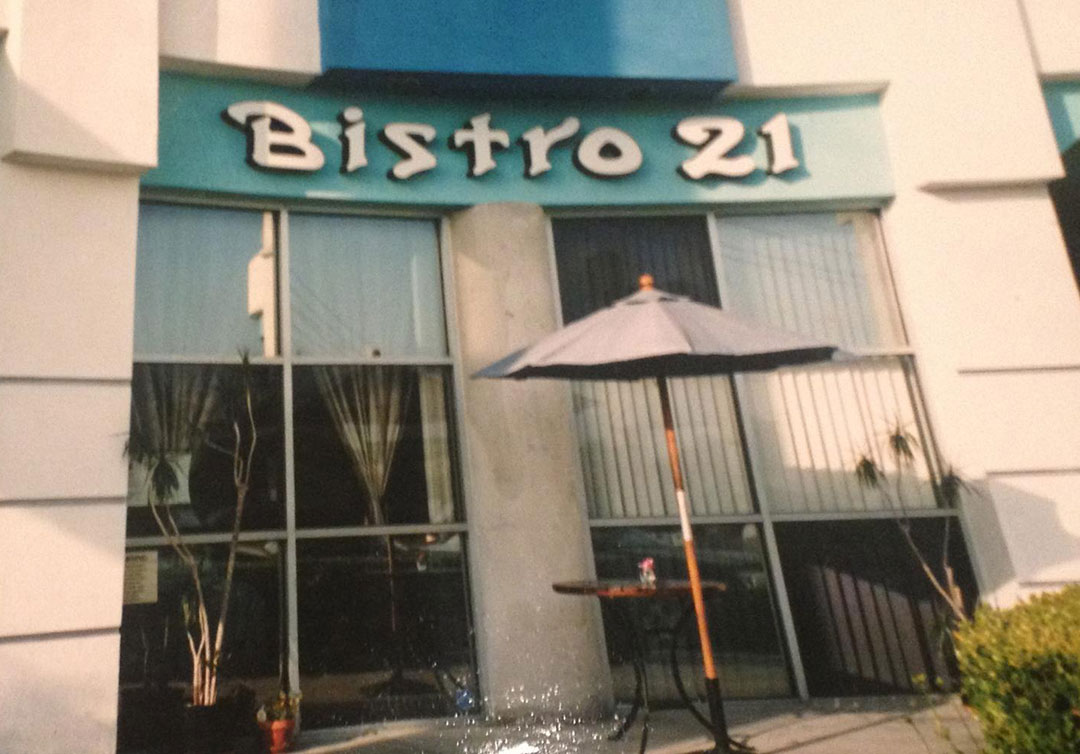
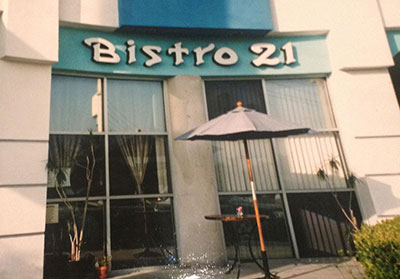
My Otto, Koh Kikuchi, is a one-man brigade. He controls the temperature of the bisque, the thickness of the rib sauce, the consistency of the fromage blanc. He eyes the width of the tomato slices, the cacao percentage in his ganache, the total square inches of gelatin in his panna cotta. He prods a piece of sirloin to see if it’s done, squinting at it like a graphic designer seeing if type is lining up properly. He calculates 2πR of a cake pan so he can construct the correct length of ladyfingers which will eventually go around the circumference of a pear charlotte. He decides the fate of matsutake mushrooms (“If there’s very little smell, I throw them immediately into the sauce; if the smell is good, I know I can serve them straight up”) and checks the color of bananas (“If the bananas are perfectly ripe, then I can simply sauté; if not, then I toss them in a little caramelized sugar. It helps with the texture”). He does all this practically at the same time. He saves cleaned carrot peels to make the stock for his smoked salmon and vegetable terrine, and deep-fries his parsnip peels into delicate crisps. “Never throw anything away.” He maintains a shiso plum salt (“It’s got a sequence: First you taste the salt, then you taste the shiso and plum. Put this on food and no one knows what’s going on”), a macha-and-salt mixture he serves with his deep-fried chocolate ganache and a shrimp salt he makes by grinding dried shells into a fine powder. He cooks fish on a piece of wood that has been soaked in wine for two days; the board is salvaged from the side of a wine crate, branded with the words Chateau les Grand Maréchaux. “Never throw anything away.”
At the market, he handpicks the vegetables. “Don’t buy the really straight green beans. Get the ones that have grown completely crooked. The straight ones have something wrong with them.” He tears scallops by hand. “If you cut them with a knife, the surface is too smooth and the sauce doesn’t stick to the sides. That’s the Japanese way of cooking scallops. I learned that from a book. I read a book on Japanese cooking once.” He’s learned that humans are made up of .2 percent salt2 and uses this knowledge to calculate how much salt to add when creating a marinade for his meats.2 I’m not sure how he’s arrived at this.
3 Called “yamaimo” in Japanese, the mountain potato is a crazy tuber. More slimy then okra, more sexually connotative than a sausage, it’s eaten raw or mixed in with other ingredients as a lubricant or thickener.
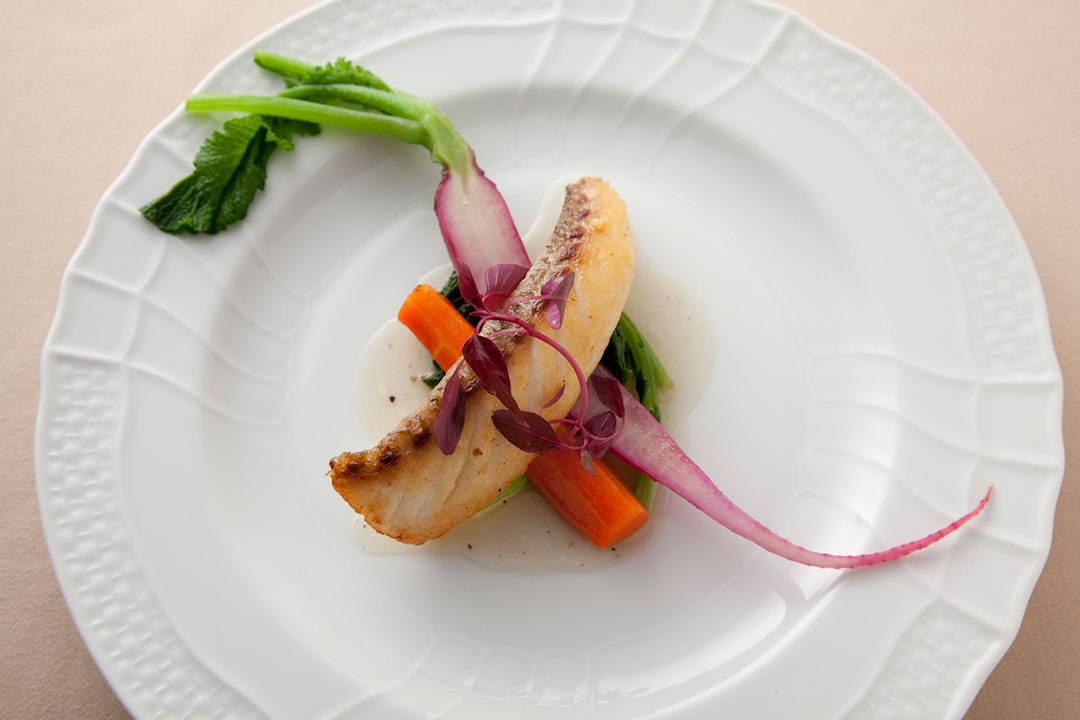
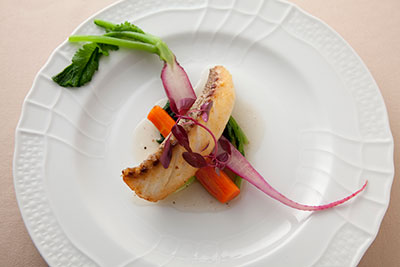
Koh was born in Kyushu, the southernmost little boot-tip island of Japan, and his family moved around often due to his father’s job in construction. His mother passed away when he was 5, and Koh and his two older sisters went to live with their grandparents, who owned a farm in Osaka, for several years until his father remarried. His step-mom turned out to be what Koh calls an “evil step-person, who wasn’t really a mom at all” and eventually drove all the kids out of the house by her sheer personality. Koh “got out” by applying to one of Japan’s boarding schools, where he spent his junior high and high school years supervised by teachers well versed in military discipline: crew-cuts; push-ups as punishment; television allowed for only two hours on Saturday; packages from home screened for money, snacks and toys; exactly three minutes each morning at 5:30 A.M. to change their clothes, brush their teeth, roll up their bed futon with the utmost precision and get downstairs for sunrise calisthenics.
Koh is a Japanese French chef. There’s no dash, no slash. He’s a French chef who is true to his Japanese nature, using a host of ingredients many chefs apply cheaply in the name of “fusion.”4 He says when he goes to France and tastes some of the gastro over there, he is stunned. He knows he can’t do what they do. “It’s not in my DNA. Those things they do, the sauces, the reduction, the wine flavors, it tastes unbelievable. I can’t do it.” He clings to his French training as both foundation and strategy. He plans meals by tossing everything into a virtual blender and adjusts accordingly for taste (the balance of salty, sweet, spicy and what he calls “krrrk,” something more intense), texture (Koh’s got this thing about texture: If he wants something to have a texture, he will achieve it through any means), color, temperature and nutrition. Then he reverse engineers the mixture into elaborate and individualized courses that are microcosms of the larger plan. He does this in both direct and indirect means, the way a meal can be all about pork by using pork in every dish or the way a meal can be all about pork by using any ingredient other than pork.4 Or sometimes, in Japan, there are local ingredients Japanese chefs purposely don’t apply in the name of purity. They won’t substitute something local for something they revere as “French.” This makes for some pretty lousy French food in Japan. “Masturbation,” is what Koh calls it, the denial of one’s intrinsic nature. “You have to be true to yourself. Follow the DNA.”
Koh is his own boss. He doesn’t “just add some sesame oil and ginger slivers to bend the dish into a zen-like space” or “top smelt eggs with fois gras and Thousand Island dressing for that special … quelque chose épater les bourgeoisie.” He’s East-meets-West at a level very few chefs get the chance to reach. If he wants to make a dish that has a very high food cost, he will bite the bullet and do it. With his prix fixe/omakase menus (two options: $45 or $75), he is able to change what he serves at the last minute and does depending on mood. He keeps track of whether a customer’s allergy is the entire shellfish category, bivalves only or just crab, or if the person is anti-mushroom, squeamish about tomatoes or panicked when faced with undercooked meat. He knows who likes to pick at pan-fried fish heads, whose friend has a pet chicken and therefore won’t eat one, and how to satisfy the crazies. (“You sneaky devil, you. What’s in here? It’s strawberry — no, cherry — grape, no? What is it?”)
On top of that, Koh sees the field differently. His movement between smoked salmon, makaibo seaweed, gherkins, daikon, escargots and miso sauce appears effortless and unhindered by thought. It’s as if he has an uncanny knowledge of which way the wishbone will break, how the eggplant’s going to broil, which angle the puff pastry is going to lean. He understands the temperament of a lamb chop, the muscle tone of a scallop, the homesickness of a salmon. On his side, he’s acting out of responsibility to the ingredients, but ultimately he knows that doing things in an unconventional manner can lead to failure and customers are often unpredictable. In “Brigade de Cuisine,” McPhee’s Otto says, “Many people who eat here seem to appreciate it … thirty percent are excellent eaters. Ten per cent are fun to talk to. Five per cent know about food and really enjoy it ….’” I asked Koh whether he thought 5 percent of his customers actually knew what he was doing. He closed his eyes for a moment and answered, “Maybe 5 is a little high.”
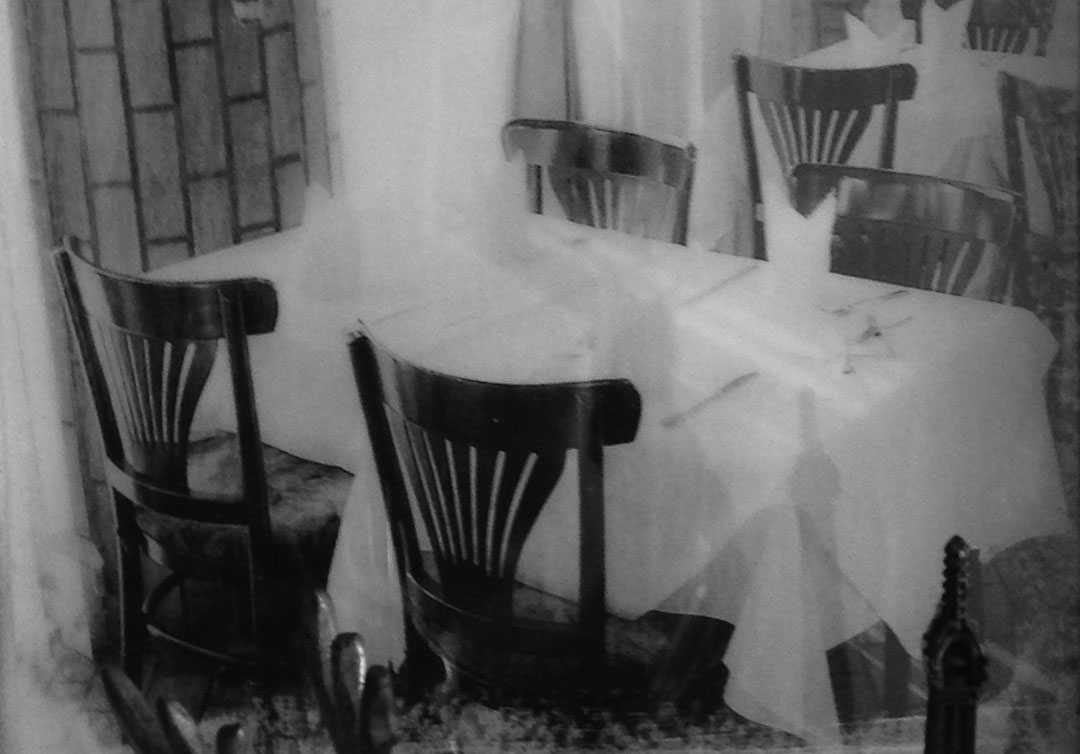 Interior of Bistro 21
Interior of Bistro 21
But it is this less-than-5-percent that has regularly come for dinner, many of them over 50, 75 times and nobody has ever had the same dish twice. Here in Los Angeles, it’s not surprising that his customers are a mix of businessmen, graphic designers and movie folks, but his true regulars are jazz musicians and music industry professionals. His cuisine is well suited for the impromptu structure and rhythms of jazz, where the repetition of a single note is a study in variation rather than a display of echolalia.
It’s the dreamers among us who think if one eats there enough times, Koh will inevitably serve the same dish again. Truth is, Koh makes it up every time, so there’s nothing to “go back to.” I have met a certain individual who, during the time he was away at college, had to endure via telephone not only the play-by-play descriptions of what his parents, sitting at Koh’s Bistro 21, were eating, but also the plummeting worry that the dessert they would be served that evening would be the one particular ice cream lodged in his memory. It is for this dessert that he arduously prays he will be in the right place at the right time when the potent combination of flavors makes its lonely sinuous path back to Koh’s brain.
He doesn’t have to worry anymore. Koh is closing shop. After 9/11, the U.S. government tightened the belt on visas, and in 2005, he and his wife Aki were informed their business didn’t meet the new minimum capital gain requirements necessary for an extension. Their two options were either to enlarge the business or leave the country. That left really only one option.
A chef like Koh cannot expand. He is unable to do it. He cannot willy-nilly add a take-out menu or start serving lunch. He cannot thaw some frozen fish, buy in bulk, downgrade the soup stock, chop the truffles smaller or make a concerted effort to turn tables.5 He will elect death by grease fire before he’ll allow his smiling mug to sell a bottle of ponzu or olive oil. After 18 years in the U.S., 18 long years of six-day work weeks, Koh and Aki are going back to Japan. Koh says they could possibly hire a lawyer, but Aki wants to go back. He jokes it’s because he promised Aki’s father when she first visited the U.S. that he would bring her back within two years.5 On average, Bistro 21 served 10 to 12 people a night.
My first thought when Koh told me they were going back home was purely selfish and wrought with panic: “Where am I going to eat now?” The second thought was to ask if I could sit in his kitchen and take notes. This appears to have been even more selfish than the first. Koh’s response was “I will be honored. You can share the staff meals with us.” He may as well have said, “I am honored that you will create more work for me.”
In between all the cooking, Koh cleans. At any moment, the kitchen looks as if the evening is over and the stove burners are the only items remotely unkempt. There is no ghastly pile-up of frying pans, tongs and cutting boards in the sink. Watching him move dirty pots to the sink, cleaned pots to the racks and dried pots back to their hooks is like watching a seasoned Photoshop artist remove the background from an image of a long-haired cat lying on an angora blanket. There is no tool that makes the process easier, but there’s evidence of a strategic plan. The cleaning is part of planning what to cook. It’s not like the manual part of the labor all of a sudden looks easy or that Koh “makes cleaning look fun,” but he certainly makes it look smart.
Koh’s Zagat lineage mentions Kyoto-Tokyo-Lyon-Los Angeles. That’s his training. The tinkering, the experimentation, the calculations, that’s his DNA. He can’t help it. If he’s rolling up a piece of sole, he’ll think, “Now what if I brush on a little sauce made from ground kinome,6 leaves? It will make the flavor really interesting, the customer will really wonder,” or, “It’s very hard to deep-fry ganache. It melts, so I wrap mine with filo dough and cover it with panko. This way it sort of explodes when you eat it.” He thinks of himself as a “carrier of cuisine” to inspire people, to show them what food can taste like with the right knowledge, care and understanding. Sometimes he claims he’s done absolutely nothing to a hunk of meat and the juices just give themselves up. “Simple food can be really great,” he says, pausing before adding, “but one has to really care a lot.”6 Hands down, this is the shit. Kinome is the tender leaf tips of the prickly ash tree, also known as Sansho or Sichuan peppercorn.
There’s no pastry chef, no sous chef, no salad prep, no cleaning crew, no wait staff (occasionally they had someone on the weekends to help Aki), no dishwasher, machine or human. Aki is the host, waits tables, serves coffee, pours the wine and goes through the mail, and Koh does everything else. And cooks the staff meals. And bakes the bread. And fixes the espresso machine. And cleans the bathrooms. And translates for Aki. Washing dishes they share, and for this reason the long and narrow kitchen has two main sink stations — one for pots, one for dishes — separated by a total of 14 burners on one side and a long counter top sporting a 5-foot cutting board made from a Japanese rubber that caresses the blade as knife and board make contact. Its height above the floor is calculated so Koh’s forearm is perfectly horizontal at the moment when the knife comes down.
 Aki and Koh in Bistro 21’s kitchen
Aki and Koh in Bistro 21’s kitchen
Koh wears a Kangol. It faces backwards, perched at the top of his high, wide forehead. Tufts of grey hairs dance underneath the almost invisible logo. If the evening is an arduous one, those tufts vanish, trampled under the elastic from constant and nervous hat repositioning. His hands are large, huge in fact, but elegant for their size, like a concert pianist late in his career. His knuckles are gorgeous. His fingers are slender but generously segmented. There is an avian quality to their dexterity when they curl over a set of tongs, a pâte form, a scrubbing sponge. He calls pieces of meat larger than his fist “guys.”
His English, though fluent, is hampered by the classic Asian mix up of Ls and Rs with a few “you knows” thrown in here and there when he gets nervous or excited or is looking for the correct word. The challenges of expressing his thoughts in a second language catch up to him when it’s late or when there are a few glasses of French wine in him, lending his phrases a directness which is sometimes confusing (“I spent $35,000 on my gelato maker, sold my first car for it”7), but mostly awesome (“If there’s too much seasoning, I think your stomach will get tired”).7 He actually only spent $3,500.
Sometime between 5 and 5:30 in the afternoon, a second level of seriousness is reached and he changes into a black T-shirt. He and Aki then go into the back and say a quick prayer to the white figurine cat perched on a high shelf in the corner, just above the wine racks. Aki’s brother purchased the cat for them when they first opened the restaurant and had it blessed at a Japanese shrine. The cat protects their business. It knows where Koh buys his fish and on which days the fresh catch from Japan will arrive.
Unlike some chefs, Koh’s towel is not a permanent fixture on his shoulder or in his back pocket. It pops out from nowhere and snaps back out of sight after the wiping is performed. When he cleans the floor, he bends low and attacks the corners as if he’s wrestling with the mop, turning it over and over, soaking up the last drops of a marinade. Koh is good at cleaning. At 17, he got a job at McDonald’s in Kyoto where he was placed in the lowest tier: maintenance. Almost overnight he was promoted to the deep-fry tier, responsible for Filet-O-Fish, apple pie and French fries. After the deep-fry tier, which “totally stressed him out,” he was promoted to the grill, where he prepared the buns (“done in one minute”), the patties (“absolutely no part of the patty is to overlap its neighbor”) and the finish (salt, dried onions, lettuce, tomato and Thousand Island dressing). He never graduated from the grill. He says it was too hard, a total Hell. But the hard part for Koh wasn’t the workload; it was how rigid the system was. Everything was on a timer or multiple timers. Man and food were mechanically controlled, and there was no place for a hands-on philosophy dedicated to quality.
After his shift at McDonald’s was finished, he’d put in another day’s work at the Miyako Hotel peeling potatoes and carrots with some floor and bathroom cleaning thrown in for color. That’s it. Hello potato. Hello carrot. For the first three years that was his job, and I can attest there is nothing more sublime than watching Koh peel a carrot. The peels lift off effortlessly from crown to tip, in perfect slivers, then each one curls up and rolls over to the right and rests. An entire bag of carrots is denuded in minutes.
In Kyoto, Koh worked two jobs because his father had gone bankrupt and couldn’t make regular tuition payments for his last few years of high school. At the end of his senior year, the principal told him they couldn’t let him graduate on account of missing funds. Koh promised the principal that if he let him finish, he would pay back every single penny of what he owed. So for six months Koh moonlighted, bouncing around on two hours of sleep a night.
On his precious days off, he offered himself to the other stations at the Miyako — fish, grill, pastries, vegetables — in the interest of expanding his potato and carrot peeling skills. In search of more things to do, Koh tried his hand at ice carving. He’s not sure why, but it seemed like a fun thing to do. He thought he liked doing things with his hands. His “debut” was a five-tiered pagoda made from a block of ice originally weighing 300 pounds, towering some 5-feet high and cut using chain saws, long-handled chisels and a host of other specialized tools. The management decided this was a skill they could use and sent him into the freezer to carve swans, dragons, cherubs, harps and marlins for the hotel banquets. Koh says he sometimes carved until he no longer could feel any part of his body. “If I was born a long time ago, I would’ve been one of those master craftsman, I think,” Koh remarked, “carving dragons and boats and stuff.”
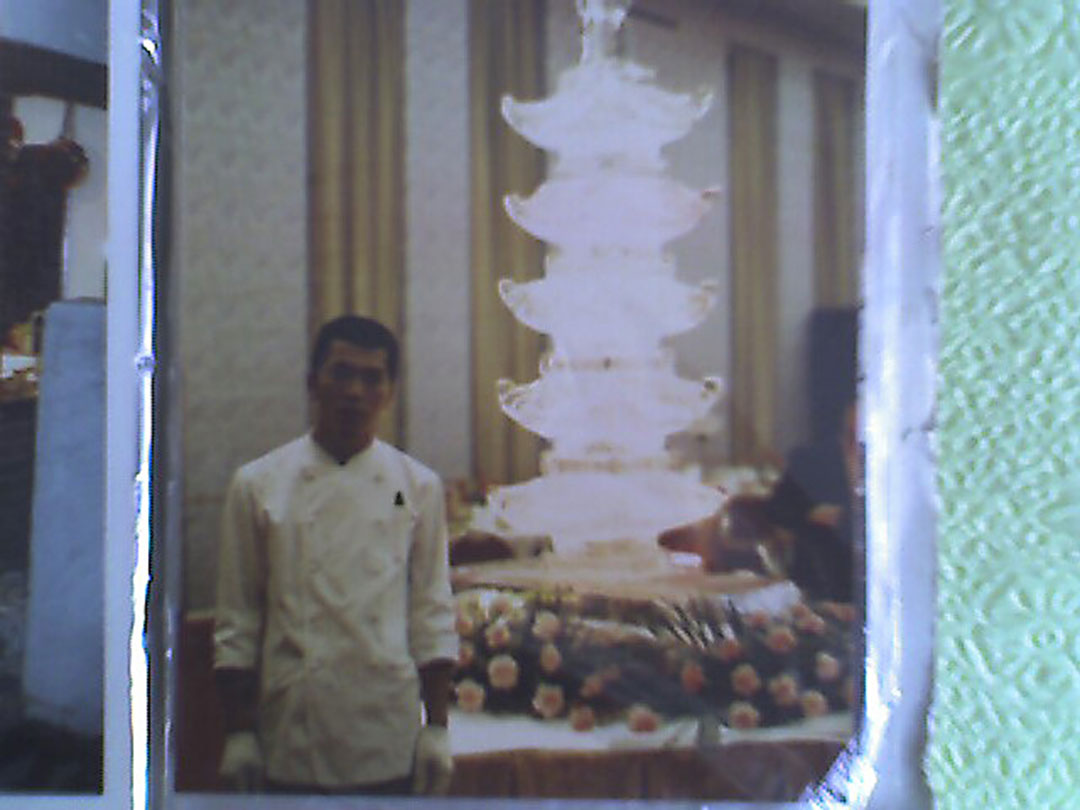 Koh with one of his ice sculptures
Koh with one of his ice sculptures
Eventually the Miyako (which, in the sorrows of Japan’s big economic bust in the ‘70s, was staffed mostly by independent contractors) offered the coveted Real Employee Status to the kitchen staff if they agreed to be transferred to either a second Miyako Hotel, a cut and dry business hotel, to serve hot tea and snacks, or to handle food carts and operate the microwave on the Japanese Rail System. Real Employee Status being the Golden Chalice in Japan, meaning a huge bump in pay, a lifetime contract, all sorts of benefits, retirement and social status, the offer was quite tempting, especially for the times. For Koh though, the whole chef thing was starting to get interesting. Out of the entire staff, he was one of two people who declined the Mikayo’s offer, electing to stay on as assistant to the sous chefs. The sous chefs, who liked to lord their little power over those lower in the food chain, grew fond of Koh because he kept track of how each chef liked to set up his station. Filling three notebooks, he drew maps of each chef’s idiosyncrasies, which side to place the spatula, which knife is the “go to” knife, the preferred slotted spoon size, etc.
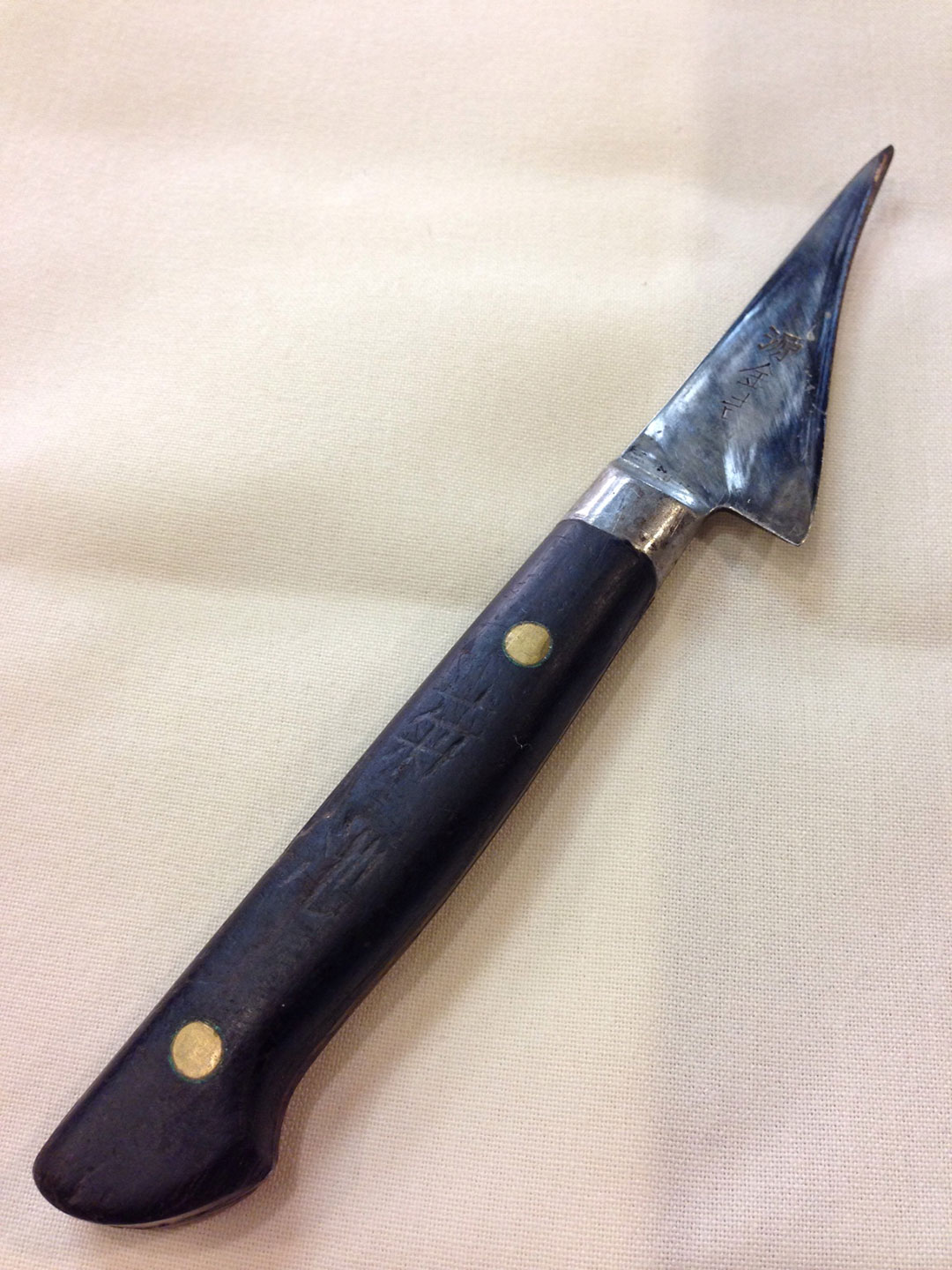 Koh's knife from the Miyako with his name carved into the handle
Koh's knife from the Miyako with his name carved into the handle
Acting as sort of a splash-guard for gases, a smoke-colored piece of Plexiglas hangs perpendicular to the wall high above Koh’s golden cutting board. Just below this screen is a shelf holding all of his knives. Some are sheathed in corrugated cardboard and duct tape. Others glint and show off the Japanese characters carved on their blades and handles. He pulls one down and hands it to me. It looks like a mutated runt. The blade is 2, maybe 3 inches long. “It used to be this long,” he says, holding his hands about 7 inches apart. “My first knife,” he adds. “The Miyako buys you a knife when you become a chef there. But if you are a chef at the Miyako and you quit, they make you return the knife. So when I left after seven years, instead of giving them back the same knife, I went out and bought them a new one, carved with the same brand. That knife is 30 years old.” He puts it back on the shelf, fiddling with the others so they are all lined up perfectly straight on the shelf. “Knives have a memory. That one is still great for peeling fruit.”


Just before 3 in the afternoon, Aki arrives and deals with the mail, straightens up from the night before, sets the tables and makes sure Koh’s cellphone is charged. She offers me a chair and makes herself an iced coffee. Koh slices some heirlooms, wipes the board, preps a hunk of meat. He reaches over the edge of the counter to drop a handful of trimmings into the trash. Aki, out of courtesy to me, has moved the trashcan so it’s not in my way. Koh stops just before releasing fat and pulpy matter into thin air and laughs. He doesn’t get angry, he laughs. “We’re such creatures of habit, so stupid,” he snickers, but nods when I move the trashcan back to its rightful place.
Today the staff meal is stir-fried cabbage, eggplant, broccoli and pork over rice. While we eat, Koh says Aki sometimes complains the staff meal is terrible. She hits him and calls him a liar. He says, “I always tell her, if you don’t like it, you don’t have to eat it.” They are joking around. There is very little discord in their marriage, just the usual blow-ups of couples who work together for more hours than recommended, which leads to arguing over some really stupid stuff, like whose arms hurt more or who’s feeling more tired. Laughing, Aki says, “Customers ask if I ever get to try the food, and I say no. They ask me what I get to eat. I answer sometimes I get rice and maybe some miso soup.” She isn’t complaining and does actually prefer this type of meal, though I can imagine some customers think she is being starved. Watching her struggle with putting her thoughts into English makes it easier to imagine them back in Japan. According to Koh, when they first met (while he was on vacation in Tokyo), Aki had nothing but beer in her fridge (she claims there was also a bottle of soy sauce) and subsisted on McDonald’s, instant ramen and onigiri. The first thing they did when they got married was visit France so she could see what the cooking, the food, the service, the fuss was all about. He had told her one day he was going to own his own restaurant. He probably never mentioned the fact that he didn’t intend on having a staff.
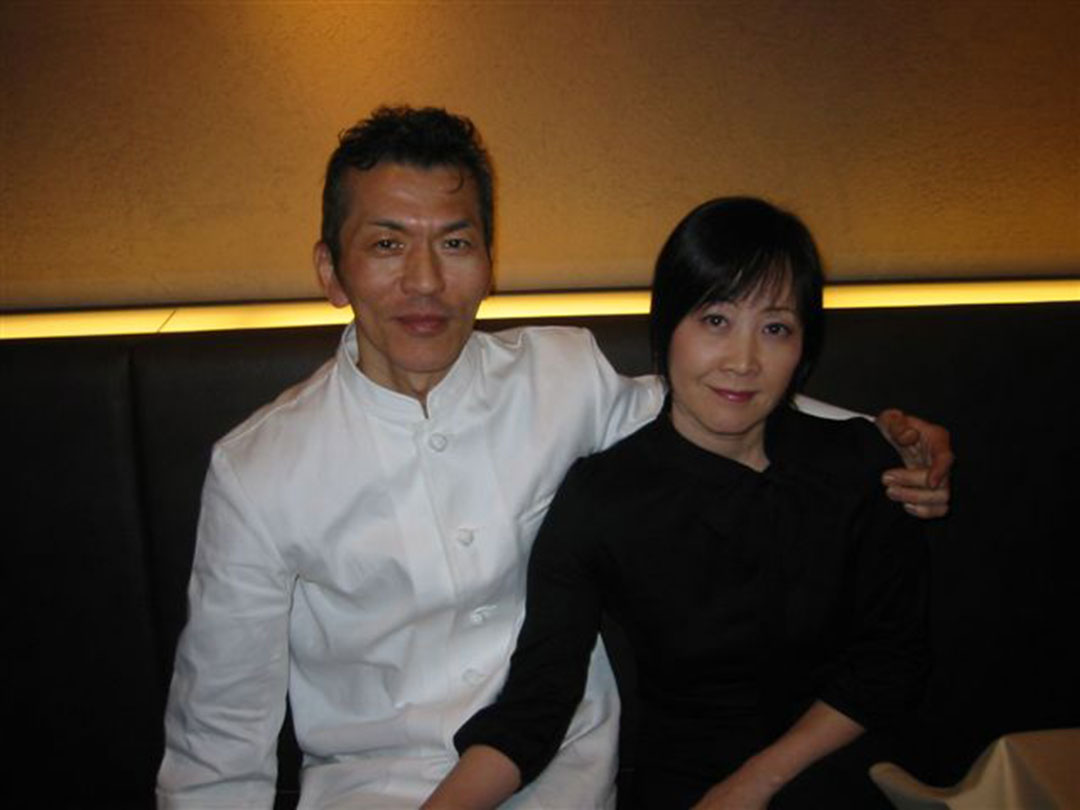
Aki is wearing a lavender T-shirt and purple flip-flops with matching eye shadow. While she prepares for the evening, she clips her long bangs to each side, removing them at the same moment Koh’s black Kangol goes on. Her evening outfit matches his, except her apron almost touches the floor. Jewelry she keeps at a minimum, though earrings and necklace are always matching. Occasionally she’ll run a quick hair dye through her roots just before the customers arrive. “Shhh,” she whispers, “It’s a secret,” and tries dabbing some on Koh when he’s not paying attention. Her pretty face is soft and expressive, and I wonder if she’s developed this repertoire of expressions over the years because it’s so difficult for her to speak her mind in English. Included in her repertoire are several sad faces that she hides from the public. They are tainted with frustration and full of the stubbornness and sheer willpower she depends on to make her day-to-day life linguistically possible. Since arriving in America seven years ago, she has not had the free time or the urgent need for extended and regular practice using the English language, so her public persona appears quieter, more docile than she really is. After the customers are gone, she will throw her fists into the air and scream in Japanese what she had wanted to say hours or weeks earlier. Koh does not translate these outbursts. Now that she knows they are going back to Japan, she is equally upset that she will no longer put to use the English she has tried so hard to learn.
Aki is Koh’s spy. She watches to see if customers leave certain foods on their plate or port them over to someone else’s, watches their facial reactions as they chew. Compliments she strains to memorize and repeat in the kitchen when she knows Koh is listening. She jots down gut reactions to unfamiliar voices calling for reservations. Sometimes her notes are as obtuse as “customer did not understand my English at all,” but that is all Koh has to go by in terms of what and how to cook for this stranger. Since Bistro 21’s opening night, Aki has maintained a series of three-ring binders documenting each evening — who ate what, what the reactions to the food were and esoteric thoughts about the atmosphere. Handwritten in 4-point Japanese script, the margin-less pages are filled edge to edge, even the space between the three holes. Flipping through them feels scary, awe-inspiring and voyeuristic.
Though there may be a wall separating them when they work, Aki has a third eye that hones in on Koh’s every move. She can tell if a burner is left unattended, if the tongs are about to topple, if a lid is only half on. She anticipates where he is in preparing the next dish and estimates exactly how many spoons can be washed and dried before he needs her to help him serve the hot plates. She watches and studies everything. None of this comes easily to her. Each evening she writes down in Japanese all the courses planned for the night and for each guest, including the list of special ingredients and where they are from and how each dish is prepared. She eyes the guest list and scouts out which customer will pepper her with questions about what he/she is eating and prepares as many answers as possible. She rehearses, from first course to dessert, so that she can be as informative as possible. When Koh changes the menu midway, she will cover her mouth in alarm and rush back to the kitchen for an explanation. She gets angry when she has to serve something she isn’t prepared to pronounce. Sometimes Koh will come out himself to right the wrong, whispering “forgive me” to Aki as he passes by.
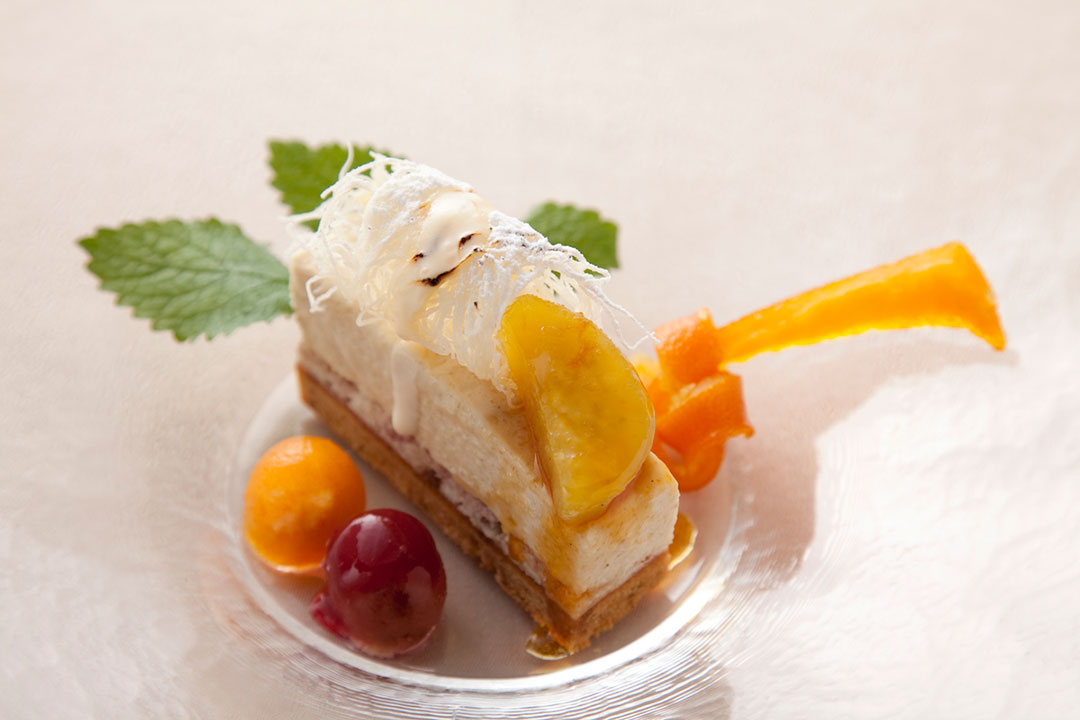
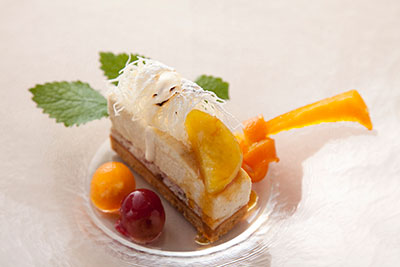
After the Miyako Hotel, Koh worked for a French restaurant in Tokyo for about three years, through which he was able to study in Lyon for a year as part of a chef exchange program. Leaving France, which he calls “the only thing in my life I regret,” he went back to Kyoto and met an American who somehow convinced him to try the United States as the destination for his next adventure. So in 1988 with $2,000 in his pocket, he arrived at LAX, hoping to somehow sleep in the airport until he could figure out his next move. Though it was very close to Christmas, airport security was in no mood to be generous. Through a contact, he got a job as a nanny for a couple in Costa Mesa, changing diapers, cleaning and gardening. Since they already had a cook, they never asked him and he never told them. He didn’t have the time.
The husband was a tough Jewish cookie who didn’t want to hire him at first, but relented after Koh offered a free trial week. The couple ran a business conducting therapy sessions for stressed-out corporate executives, and the husband was up at 4 every morning for meditation in his no-leaf-out-of-place Japanese garden (kept immaculate by Koh, who was up at 3 in order to fend off fallen leaves and pine needles grown askew), followed by a long morning jog that concluded with a veggie juice Koh was to have waiting for him when he returned. Koh, after almost 20 years, can still recite the exact recipe of the man’s juice: “half teaspoon salt, olive oil, spinach ….” At the end of the week, the husband pulled him aside and said, “I don’t like you, but you can stay.”
A few months later, the husband fired their cook over a broken refrigerator, blaming her for the malfunction. Knowing that in one week they were supposed to host a dinner party for 20 or so clients, Koh had asked, “Who’s going to cook?” The wife replied that she was going to, and Koh offered to do his best to help. He was sent to Pavilions supermarket with a long shopping list and instructions on how to select produce. When he returned, the wife figured she would start him on something simple and handed him a carrot. The next minute her jaw practically hit the counter and she asked, “Oh my God, can you cook?” “A little,” Koh replied, pulling another carrot out of the bag. After a brief pause, she said, “Why don’t you make dinner for us tomorrow night, you can make whatever you want.” Koh agreed, and he made what he knew was the husband’s meat of choice: lamb. Koh told me, “Even though the lamb was from Pavilions, because that’s where they sent me, it came out pretty good. I think there was also some salad and a soup. In any case, they were happy.” Thrilled to discover their nanny/gardener could also cook, they asked him to go ahead and plan their upcoming client dinner and promptly cancelled their search for a live-in cook.
Koh has a thing about clarity in soups. He’s got a thing about textures. He’s got a thing about not compromising on the quality of ingredients. He’s got a thing about a lot of things. After seven months in Costa Mesa, he got a job cooking in Los Angeles and from there moved from restaurant to restaurant, learning and keeping his eye on his dream of one day being in control of his own food. So adamant is he about using quality ingredients that the issue of food costs has been his most bitter battle. After one incident, it even earned Aki $1,000. She had written an essay about how Koh had quit his job after a huge argument with the owner over food costs and staff wages, and the all-Mexican staff had thrown them a goodbye party with serapes, guitars and tequila. The essay won her first prize in a Japanese writing competition. The serape they keep in a cabinet in the back of Bistro 21 in case a customer gets cold.
On days off, Koh cruises by his neighborhood In n’ Out Burger for a double cheeseburger with sauteed onions. He says there’s one kid at the grill who doesn’t overcook the patties, and he tries to see if that kid is working before he commits himself to the drive-through. As for other fast food, he shakes his head and waves off the question.
“I’ve never eaten at Kentucky Fried Chicken, too greasy. Never at Taco Bell either. So many times the Mexicans I worked with came in with stomach aches from eating there. They say it’s terrible.”
“Wolfgang Puck’s frozen pizza?” I ask, knowing he worked at Spago in the ‘80s.
“Nope.”
“Roscoe’s?”
“Nope. Is it good?”
“It’s fried chicken and waffles, and the syrup and the chicken sort of get all mixed up together.”
He thinks about this for a minute. “Let’s go together,” he says.
I ask him about his favorite wines.
“I don’t want to say I hate California wines, but I hate California wines.” He prefers Chateauneuf-du-Papes and Burgundies in general, though he thinks Bordeaux wines go better with his cuisine.
“Ever bake a potato in aluminum foil?”
“No, why would you do that?”
“Ever open a can and simply serve it?”
“Oh, man.” His mouth releases a horrible whimper. The cringe is involuntary the way some faces pucker just before sneezing. “Opening a can is fine as long you do something to what comes out.”
“Are there any kinds of foods you do not like to cook with?”
“Lentils. No lentils.”
“Cheetos?”
“Oh…”
“…”
“I like Cheetos.”
“Ever consider hiring someone to help?”
His eyes perk up. “Oh yes. It’s a good thing to have to communicate with someone. Communicating helps people grow, physically as well as emotionally. I hired a sous chef once.”
“What happened?”
“What happened?” Koh smiles. “It didn’t work out.”
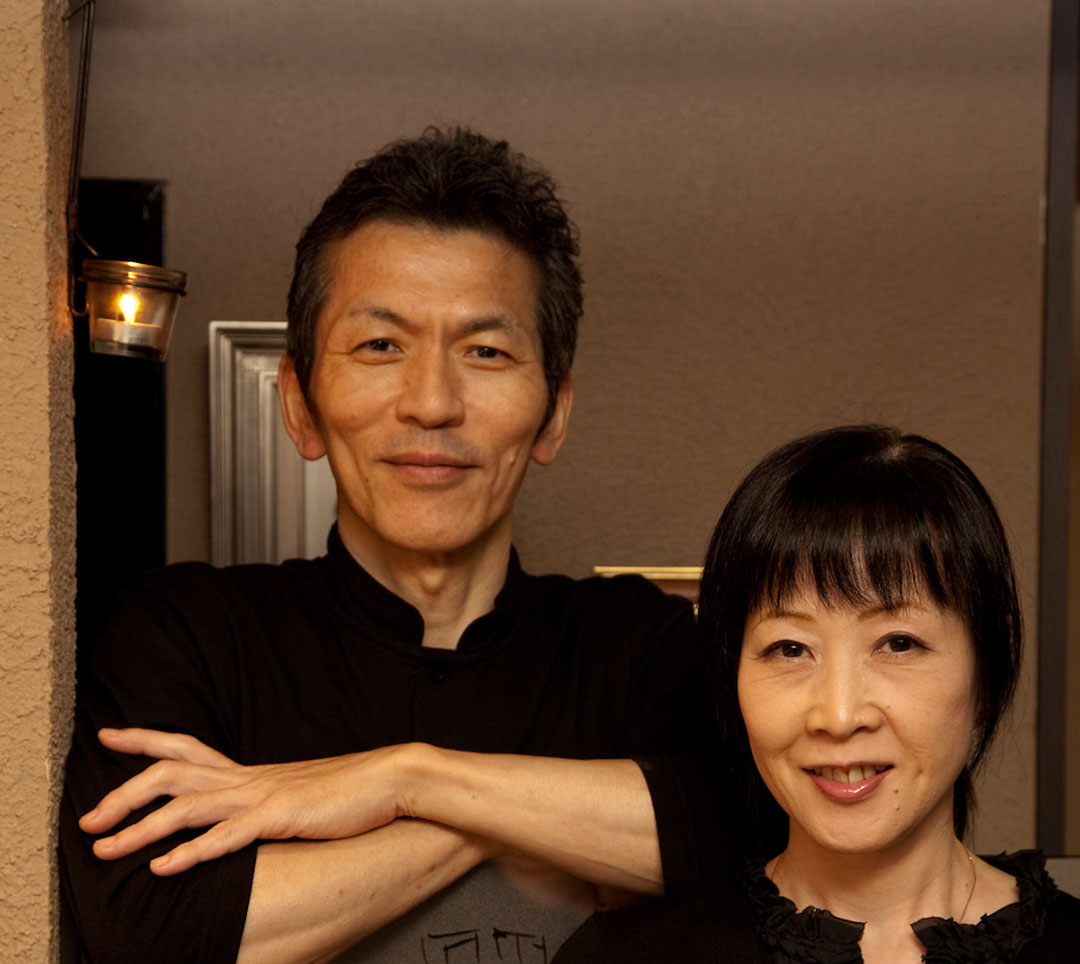
Now that Koh and Aki are leaving, Bistro 21 is returning to the Italian state it was in when he bought it seven years ago. There is a poetic beauty to the fact that both the previous and new owners are Italian, and he feels subtly indebted to the cuisine. He’s sort of a weird blip squeezed in between two ornate Italian periods.
Koh knows he and Aki are leaving behind a loyal community. One of the things he would like to do before leaving the country is to give all his customers advice: Go easy on your sons, let them date, do this, talk to your boss, relax, do that.
At the restaurant’s closing party, there are around 40 adults, mostly strangers, hugging and asking the same questions: “Where are you going to eat now?” or “How did you find this place, in this weird mini-mall?” I ask him if this is what he imagined his life being, some sort of community maker. He shrugs. “People bring a lot of emotional stuff to the table. Chefs get to work with that. This is why running a restaurant is so interesting.”
In 2006, shortly after all of the above was written, Koh and Aki returned to Japan and opened a restaurant, but after five years, they had to close. I was never able to eat there, but a friend who did told me it was “the same cooking but imagine it with the best possible ingredients.” Koh always said someday he’d come back to the U.S., and last month he accepted a position at the unfortunately named I Love Sushi, a restaurant whose owner wants to introduce Japanese French cuisine to Bellevue, Washington. O lucky people of Seattle.
Angie Lee is an artist and writer living in Los Angeles. Raised on the top of a water tower in Los Alamos, New Mexico, Angie holds an MFA in painting from Cal Arts and has exhibited in both the U.S. and Europe. Her writing has been published in Witness, Giant Robot and The Chamber Four Fiction Anthology. She blogs at Moonquake.org.
(Image credits: All photos by author, except food shots and the final portrait, which are courtesy of Masako Nagano; and the shot of Koh's knife, which is courtesy of Shige Sakuma)
This longform article about cooking is brought to you by Nine Rabbits, the bestselling novel by Virginia Zaharieva now available from Black Balloon Publishing.
About the Book:
A restless writer's fiery enthusiasm for her family's culinary traditions defines her from childhood to passionate adulthood as she strives for a life less ordinary. Lush gardens, nostalgic meals and sensual memories here are as charming as the narrator herself.
About the Author:
Virginia Zaharieva was born in Sofia, Bulgaria in 1959. She is a writer, psychotherapist, feminist and mother. Her novel Nine Rabbits is among the most celebrated Bulgarian books to appear over the past two decades and the first of Zaharieva's work available in English.